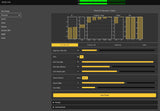FM/HD Radio™ Broadcast Processor with Network Interface
The DAVID IV 719N is the fourth generation processor in our DAVID (vs. Goliath) series of FM and HD Radio™ air-chain processors. Our streamlined, 100% DSP-based audio engine gives you total leverage over the most important sonic ‘signature’ parameters, while smart controls allow you to enhance program material quickly and effectively.
Processing includes 5 bands of dynamics compression with equalization, intelligent gain-riding AGC (Automatic Gain Control), Bass and Stereo Field Enhancements, and our proprietary PIPP™ (Polarity Independent Peak Processing) limiter.
Processing is integrated with a high-performance stereo generator, featuring multiple independent level outputs, and an RDS sync with active and metered internal combining.
Also included are 25 factory presets optimized for popular contemporary world formats and 20 customizable user presets that can easily shared over station networks.
The DAVID IV 719N may be set up and controlled using the intuitive front-panel menu display and jog wheel, or through an intuitive Network Web GUI.
Features
-
Intuitive, menu-driven set-up and IP interface for remote Web access and control
-
25 factory presets and 20 customizable presets
-
IP connectivity for SNMP monitor and control
-
Streamlined 4th Generation DSP-based audio processor
-
5 Bands of Dynamic Range Compression and ´Graphic EQ´
-
Precision FM Stereo generator with dual outputs, internal metering of your RDS/RBDS subcarrier
-
Multilingual Front Panel Menu in English, Spanish, and Portuguese
-
HD Delay (optional)
Specifications
PERFORMANCE SPECIFICATIONS
Frequency Response
- Composite/MPX Output: ±0.25dB, 20Hz–15kHz assuming the use of a lab-quality FM-multiplex decoder with the appropriate de-emphasis characteristic
- L/R Line Outputs: ±0.25dB, 20Hz–15kHz through an appropriate de-emphasis network in the FM mode; ±0.25dB, 20Hz–20kHz in the Flat mode
- AES Digital Output (Digital Input): ±0.25dB, 20Hz –15kHz through an appropriate de-emphasis network in the FM mode; ±0.1dB, 20Hz–20kHz in the Flat mode
Noise (unweighted)
- Composite/MPX Output: SNR >85dB with carrier modulation at maximum output level through an appropriate de-emphasis network
- L/R Analog Line Outputs: Residual Noise better than 100dB below the output clipping point(through an appropriate de-emphasis network in the FM mode)
- AES digital Output (Digital Input): Residual noise better than 130dB below 0dBFS (through an appropriate de-emphasis network when indicated
Distortion
- Composite/MPX Output: <0.01% THD using an appropriate de-emphasis network
- Line Outputs: <0.06% THD in digital and analog Line Outputs using an appropriate de-emphasis network when indicated
Stereo Separation
- Composite/MPX Output: >65dB, 20Hz-15kHz assuming the use of a lab-quality FM-multiplex decoder with the appropriate de-emphasis characteristic. Linear Crosstalk (main/sub or sub/main):.78dB
- L/R Analog Line Outputs: At 1dB below the output clipping level, >100dB through an appropriate de-emphasis network in the FM mode; unweighted in the Flat mode
- AES Digital Output:At 0dBFS, >130dB through an appropriate de-emphasis network in the FM mode; unweighted in the Flat mode (using the Digital Line Input)
Program Signal Latency
≤4.2 milliseconds, any input to any output in any operating mode
19kHz Stereo Pilot Protection
65dB with reference to 9% pilot injection
38kHz Suppression
80dB with reference to 100% carrier modulation
57kHz RDS Subcarrier Protection
65dB with reference to 5% RDS sub-carrier injection
REAR PANEL APPOINTMENTS
Digital Line Input
The AES3 stereo input (XLR) accepts program sources at sampling rates of 32kHz, 44.1kHz, 48kHz and 96kHz; 16/24-bit. Input gain is adjustable for average program levels between -5dB and -35dB, re: -20dBFS.
Analog Line Inputs
L/R active balanced/bridging (XLR) inputs accept average program line levels between -15dBu and +15dBu; +26dBu max peak level. Impedance is 600 ohms
Line Outputs
The Digital and Analog Line Outputs may each be configured independently for 20kHz flat response, or for 15kHz ‘FM’ characteristics, either with pre-emphasis or normalized to flat.
Digital Line Output
The AES3 (XLR) stereo output may be adjusted between -20dBFS and 0dBFS, corresponding to 100% (peak) carrier modulation. The output sampling rate may be set to follow the Digital Line Input or forced to 32kHz, 44.1 kHz, 48kHz or 96kHz. Sampling resolution is 24 bits.
Analog Line Outputs
Active balanced (XLR) outputs are adjustable between -10dBu and +24dBu (+21.5dBm), corresponding to 100% carrier modulation; source impedance is 600 ohms.
Composite/MPX Output
Two unbalanced (BNC) outputs are independently adjustable between 0.8V p-p and 8V p-p (+11dBu), corresponding to 100% carrier modulation; source impedance is 75 ohms. Pre-emphasis may be set to 75μs, 50μs or OFF.
RDS Input
Unbalanced/bridging (BNC) input accepts a 57kHz RDS subcarrier at any level between 0.5V p-p and 5.0V p-p for a typical injection level of 5% of total carrier modulation.
19kHz RDS Sync
When RDS is enabled, the Sync Output (BNC) delivers a 5V p-p TTL-compatible square wave at the 19kHz pilot frequency; 75-ohm source.
Network Port
A RJ45 jack accepts TCP/IP network connections for remote setup and operation of the DAVID IV 719N using any Web enabled device and SNMP is fully supported.
Headphone Jack (Front Panel)
A quarter-inch (TRS) headphone jack allows the user to monitor the processed program audio. A volume control next to the jack adjusts the listening level.
AUDIO PROCESSING FEATURES
Program High Pass
A user-programmable high-pass filter attenuates sub-audible noise that could compromise modulation efficiency. The filter is adjustable between 20Hz and 65Hz.
AGC
Unobtrusive, gated ʻgain-ridingʼ AGC is quasiaverage- responding with a capture/correction range of ±18dB. Positive AGC gain may be truncated to any value between +18dB and 0dB; the AGC correction rate is programmable.
Stereo Enhancement
This dual-action utility effectively broadens the soundstage for the stereo program and the centerchannel ʻsoloʼ component independently.
5-Band ʻMultipressorʼ
Program audio is split into five frequency bands. Each band imparts both dynamic compression and adjustable static gain to afford fixed equalization and other ʻsignatureʼ control of the program audio.
Bass Augmentation
Sub-bass program frequencies undergo independent dynamic compression, expansion, selective clipping and filtering for control over both static ʻRumbleʼ and dynamic ʻPunchʼ of bottom-end components.
PIPP™ Peak Limiter
Inovonicsʼ exclusive Polarity-Independent Peak Processing assures optimum modulation of the FM carrier or other delivery channel.
ITU Multiplex Power Control
The Peak Limiter section may optionally be configured to control the r.m.s. power of the composite multiplex signal to meet the European Standard ITU-R BS.412.9.
Adaptive Pre-Emphasis
Fast HF limiting and distortion-cancelled clipping are each utilized to best advantage in providing independent amplitude control of program frequencies subjected to the FM pre-emphasis curve. This helps preserve program brightness and clarity despite power bandwidth constraints native to FM broadcasting.
Composite Clipping
At the userʼs discretion, up to 3dB of clipping may be applied to the composite/baseband signal. Clipping is performed before the injection of the stereo pilot and RDS subcarrier.
HD Radio™ Delay
The composite/MPX output of the DAVID IV may be delayed between 1ms and 9.999 seconds in 1ms increments, relative to the analog and digital program line outputs when they are set to the 20kHz (Flat) output mode. When set to the FM mode(s), the line outputs are subjected to the programmed delay as well.
THE USER INTERFACE
Front-Panel
A front-panel graphic display and jog wheel allow easy, menu-guided in-situ setup and operation of the DAVID IV. LED-bar displays indicate in/out levels and audio processing action.
Network Control
Full function ‘responsive’ Web interface works on any desktop, tablet or smart phone. SNMP support allows control and monitoring of all settings. Emails can be sent for various alarm conditions.
Processing Presets
25 factory presets are provided and optimized for popular world formats, and an additional 20 custom user settings can easily be saved and shared across station networks.
MISCELLANEOUS
AC Mains Requirements
105–130VAC or 210–255VAC, 50/60Hz; 8 watts
Size and Weight
1¾”H x 19”W x 13”D (1U); 9 lbs. (net) / 12 lbs. (shipping)
Environmental
Continuous operation at ambient temperatures between 32ºF/0ºC and 122ºF/50ºC; 0-95% relative humidity, non-condensing, altitudes to 10,000ft/3,048m.










